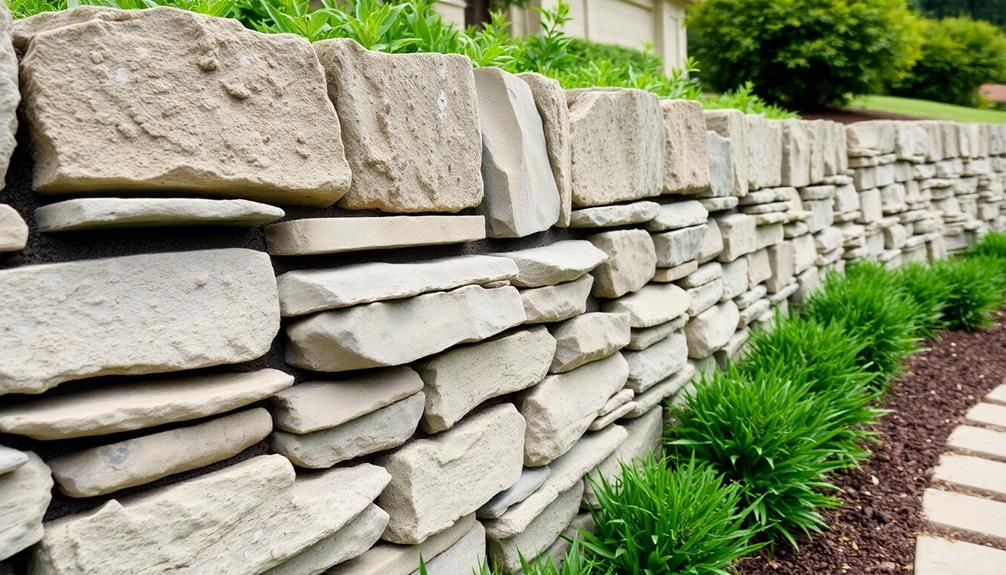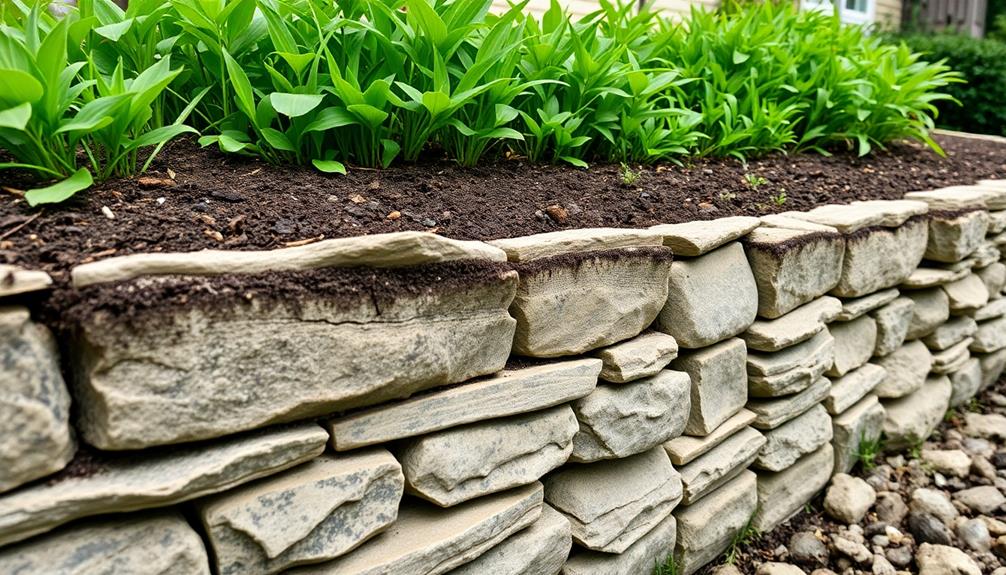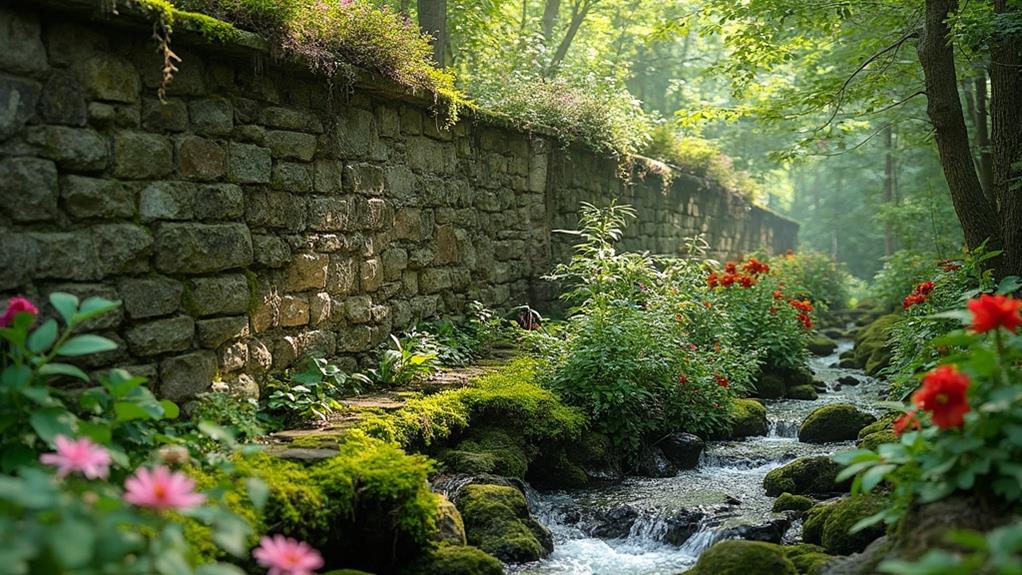Retaining wall maintenance is fundamental for preserving structural integrity and preventing soil erosion. Regular inspections are crucial to detect any cracks or structural deformations, while effective drainage systems forestall water accumulation that could compromise the wall's strength. Employing high-quality materials during repairs vastly enhances the wall's durability and longevity, safeguarding against environmental impacts. Additionally, well-maintained retaining walls not only prevent terrain instability but also bolster property value by contributing to aesthetic appeal and landscape stability. The sustained upkeep of these constructions not only safeguards individual property benefits but also fosters a well-planned community environment. Explore additional strategies and practices to optimize maintenance.
Table of Contents
ToggleWalls Contractor Highlights
- Regularly inspect retaining walls for signs of damage like cracks or bulges to maintain structural integrity.
- Ensure proper drainage systems are in place to prevent water accumulation and soil erosion.
- Use high-quality materials for repairs to enhance the wall's durability and longevity.
- Well-maintained retaining walls can increase property value by improving stability and aesthetic appeal.
- Community involvement in retaining wall upkeep fosters pride and ensures landscape stability.
Definition of Retaining Walls

Retaining walls are pivotal structural elements designed to hold back soil, preventing erosion and upholding the integrity of landscapes or urban environments. These walls come in various types and are constructed from different materials, such as concrete, stone, or timber, each offering unique benefits and challenges.
For instance, boulder retaining walls are known for their long-lasting and cost-effective nature as well as their ability to boost curbside charm. The design and construction of retaining walls require careful consideration of engineering principles to affirm stability and longevity, making them essential components in both residential and commercial projects.
Purpose and Functionality
A fundamental component in landscape and civil engineering, retaining walls serve the primary purpose of holding back soil to prevent erosion and maintain a stable area. These structures are indispensable in managing landscapes, especially in regions with varying elevations. By creating a firm boundary, retaining walls not only mitigate soil erosion but also enhance the usable space in both residential and commercial properties. Their significance extends beyond mere functionality, as they contribute to the aesthetic appeal and structural integrity of an environment, fostering a sense of order and belonging within the community.
Retaining walls perform several key functions, including:
- Preventing Erosion: By stabilizing soil on a slope, retaining walls protect against the detrimental effects of rainwater runoff and ground shifting, which can lead to erosion and destabilization.
- Maximizing Space: In urban and suburban areas where land is at a premium, retaining walls allow for the creation of additional flat surfaces, making land more functional for gardens, patios, or walkways.
- Enhancing Aesthetics: Beyond their practical uses, retaining walls can be designed to complement the surrounding landscape, adding both beauty and value to a property while creating a cohesive environmental design.
These functions underscore the essential role retaining walls play in landscape architecture.
Types and Materials
Understanding the types and materials of retaining walls is indispensable for selecting the right structure to meet specific landscape and engineering needs. Retaining walls are essential in preventing soil erosion, managing water runoff, and creating usable flat spaces in varied terrains. The choice of wall type and material greatly impacts the wall's functionality, longevity, and aesthetic appeal.
Common types include gravity walls, cantilever walls, and anchored walls. Gravity walls rely on their mass to resist pressure; they are commonly constructed of concrete or stone. Cantilever walls, often made of reinforced concrete, use leverage and are suitable for taller structures. Anchored walls, supported by cables or rods anchored into the earth, provide stability for steep or high loads.
Material selection is paramount, with options ranging from natural stone, which offers a timeless aesthetic, to concrete blocks, valued for their versatility and strength. Timber retaining walls, though less durable, provide a rustic charm and are often chosen for residential projects. Each material presents unique maintenance requirements and environmental considerations.
Engaging with knowledgeable professionals guarantees that the chosen retaining wall harmonizes with the landscape while meeting engineering demands, fostering a sense of belonging to a well-planned environment.
Design and Construction
The choice of wall type and material leads directly into the domain of design and construction, where the definition of retaining walls becomes foundational. Retaining walls serve as essential structures in landscape architecture and civil engineering, designed to restrain soil to a slope that would not naturally occur. Their construction is not merely an artistic endeavor but a precise engineering task, ensuring stability and durability. Understanding the intricacies of design and construction is crucial for anyone looking to implement or maintain these structures effectively.
In the design and construction of retaining walls, several critical factors must be considered:
- Structural Integrity: The wall must be built to withstand the lateral pressure of the soil it supports, taking into account variables such as soil type, water drainage, and potential load from above.
- Material Selection: Choosing the right materials—whether concrete, stone, or timber—affects not only the wall's appearance but also its longevity and maintenance needs.
- Environmental Harmony: The wall should blend seamlessly into the surrounding environment, respecting the natural landscape and community aesthetics.
A well-designed retaining wall not only fulfills its practical purpose but also enhances the beauty and functionality of the space it occupies, fostering a sense of pride and belonging within the community.
Benefits

Maintaining a retaining wall is not only essential for enhancing its structural integrity but also plays a pivotal role in preventing soil erosion, thereby safeguarding the landscape and surrounding structures.
By ensuring a durable and weather-resistant retaining wall material, such as limestone or boulders, the longevity of the wall can be significantly increased. Regular upkeep can lead to an increase in property value, as well-maintained walls contribute to the overall stability and functionality of the property.
In addition, a properly maintained retaining wall can improve the aesthetic appeal of the property, offering a visually pleasing environment that complements the natural landscape.
Enhances Structural Integrity
A well-maintained retaining wall serves as a critical barrier against soil erosion and shifting landscapes, thereby fortifying its structural integrity over time. This maintenance is not merely a routine task; it is a pivotal process that strengthens the wall's ability to withstand environmental pressures, reinforcing it to remain steadfast and reliable.
The structural integrity of a retaining wall is paramount for the safety and stability of the surrounding terrain, and regular upkeep is essential to sustain this integrity. As part of a community that values safety and cohesion, understanding the benefits of maintaining such structures can foster a sense of shared responsibility and belonging.
To fortify the structural integrity of a retaining wall, consider the following:
- Regular Inspections: Conduct thorough inspections to identify cracks, bulges, or signs of wear, allowing for timely interventions that prevent minor issues from escalating into major problems.
- Proper Drainage: Implement adequate drainage systems to prevent water accumulation, which can compromise the wall's stability and lead to structural failure.
- Quality Materials: Use durable, high-quality materials for repairs and reinforcements, strengthening the wall's longevity and resilience against environmental challenges.
Prevents Soil Erosion
Many benefits arise from a retaining wall's ability to prevent soil erosion, a key factor in maintaining landscape stability and preventing property damage. Retaining walls serve as an essential barrier, halting the natural movement of soil caused by rain, wind, or other environmental forces. By doing so, they effectively mitigate the risk of soil erosion, which can lead to uneven terrain, compromised structural foundations, and a loss of valuable topsoil. This stabilization not only preserves the integrity of the terrain but also guarantees that plants and vegetation continue to thrive without the threat of soil displacement.
Furthermore, retaining walls provide peace of mind for property owners, fostering a sense of community by contributing to the overall aesthetic and functional quality of shared landscapes. When properly maintained, these structures blend seamlessly into their surroundings, enhancing the natural beauty of the area while fulfilling their protective role. They help cultivate a sense of security and belonging among community members, knowing their properties are safeguarded against erosion-related issues. By investing in regular maintenance and upkeep, property owners not only protect their own land but also contribute to the sustainability and visual appeal of the broader environment.
Increases Property Value
Retaining walls not only serve structural and environmental purposes but also substantially enhance property value. The presence of a well-maintained retaining wall can transform a landscape, making it more appealing to potential buyers and investors. This not only increases the overall marketability of the property but also guarantees long-term investment security.
Retaining walls create usable flat areas in otherwise uneven or sloped terrains. This allows for the development of gardens, patios, or additional recreational spaces, making the property more attractive and functional.
By preventing soil erosion and managing water runoff, retaining walls assure the stability of the land. This structural reliability is a vital factor for potential buyers, as it signifies reduced maintenance costs and fewer future repairs.
Retaining walls contribute to a polished and finished look, which is often seen as a sign of a well-cared-for property. This aspect not only attracts more buyers but can also justify a higher asking price in competitive markets.
Understanding these benefits underscores the importance of regular maintenance, ensuring that retaining walls continue to contribute positively to property value.
Improves Aesthetic Appeal
When meticulously maintained, retaining walls markedly enhance the aesthetic appeal of any property. They serve not only a functional purpose but also as a canvas for landscape artistry. The clean, structured lines of a well-kept retaining wall can delineate garden beds, creating a harmonious blend between the natural landscape and architectural elements. This seamless integration invites a sense of belonging, offering homeowners a personal oasis that reflects both style and stability.
Moreover, the choice of materials—such as natural stone, brick, or concrete—can be tailored to complement the existing architectural features of a home, thereby elevating its overall appearance. Regular upkeep guarantees that these materials remain in pristine condition, free from unsightly stains, cracks, or erosion. This attention to detail reflects pride in ownership and fosters a welcoming environment for family and guests alike.
In addition, seasonal maintenance, such as removing debris and managing vegetation, can prevent damage and preserve the wall's visual integrity. A well-maintained retaining wall, consequently, not only enhances curb appeal but also conveys a sense of care and community, underscoring the importance of aesthetic considerations in property management.
Soil Erosion Prevention

Effective soil erosion prevention is pivotal to maintaining the structural integrity of retaining walls, with key strategies including proper drainage installation, the use of vegetation for stability, and adherence to a regular inspection schedule. Proper drainage systems help redirect water away from the wall, thereby minimizing hydrostatic pressure and reducing erosion risk, while strategically planted vegetation can stabilize the soil, acting as a natural barrier against erosion forces. To further guarantee the long-term performance of these measures, a consistent inspection routine is essential to identify potential issues early and apply necessary corrective actions.
| Key Strategy | Purpose |
|---|---|
| Proper Drainage | Minimizes hydrostatic pressure |
| Vegetation for Stability | Acts as a natural erosion barrier |
| Regular Inspections | Identifies issues early for corrective action |
Proper Drainage Installation
Adequate drainage installation is a critical component in ensuring the longevity and effectiveness of retaining walls, primarily by preventing soil erosion. Proper drainage mitigates hydrostatic pressure, which can compromise the structural stability of retaining walls. Without effective drainage, water accumulates behind the wall, increasing pressure and potentially leading to wall failure.
Proper drainage involves a systematic approach to directing water away from the wall and into suitable outlets, thereby maintaining the structural integrity of the wall and preventing erosion of the soil it supports.
To achieve ideal results, consider the following essential elements of drainage installation:
- Gravel Backfill: Incorporate a layer of gravel behind the retaining wall. This porous medium facilitates water movement away from the wall, reducing hydrostatic pressure and promoting stability.
- Drainage Pipe: Install a perforated drainage pipe at the base of the wall. This pipe collects and redirects groundwater, ensuring it does not accumulate behind the wall.
- Filter Fabric: Use filter fabric to separate the soil from the gravel and drainage pipe. This prevents soil from clogging the drainage system, ensuring continuous water flow and reducing maintenance needs.
These practices collectively enhance the resilience of retaining walls, fostering a sense of safety and belonging within your community.
Vegetation for Stability
The synergy between vegetation and structural stability in retaining walls is an indication of the power of nature's design. By strategically integrating plant life with retaining structures, one can harness the natural ability of roots to bind soil particles, thus mitigating the risk of soil erosion. This practice not only enhances the aesthetic appeal of retaining walls but also contributes to the long-term durability of the structure.
The thoughtful selection of plant species is indispensable; deep-rooted plants, such as native grasses and shrubs, are particularly effective in anchoring the soil and distributing water evenly throughout the terrain.
Incorporating vegetation requires an understanding of the local climate and soil conditions to confirm that the selected flora will thrive. Plants such as creeping junipers or certain ornamental grasses are often recommended due to their adaptive root systems and resilience to varying environmental conditions. Additionally, the presence of vegetation aids in regulating moisture levels, which is essential in preventing the saturation and subsequent weakening of the wall's foundation.
This holistic approach, where nature and engineering converge, fosters a sense of harmony and continuity, offering community members not just a functional structure, but a sustainably integrated landscape.
Regular Inspection Schedule
How often should retaining walls be inspected to safeguard their stability and prevent soil erosion? Regular inspections are vital for maintaining the integrity of retaining walls and protecting surrounding landscapes. These inspections should ideally occur bi-annually; however, specific factors such as regional weather conditions and soil composition may necessitate a more frequent schedule. By adhering to a systematic inspection routine, potential issues can be identified and addressed before they escalate into costly repairs or safety hazards.
During inspections, ensure a complete evaluation by focusing on the following key areas:
- Structural Integrity: Examine the wall for any visible cracks, bulges, or signs of leaning, which may indicate underlying structural weaknesses that could exacerbate soil erosion.
- Drainage Systems: Inspect drains and weep holes to confirm they are clear of debris and functioning effectively, as inadequate drainage can lead to water buildup and increased pressure on the wall.
- Vegetative Growth: Assess the surrounding vegetation, ensuring that roots are not compromising the wall's stability, while also verifying that ground cover is sufficient to mitigate erosion.
Walls Contractor FAQ
How Often Should I Inspect My Retaining Wall for Damage?
Regular inspections of your retaining wall are vital to ensuring its structural integrity. It is advisable to conduct a thorough examination biannually, with additional checks following significant weather events, to foster a sense of community safety and reliability.
What Are Common Signs of Structural Issues in Retaining Walls?
Common indicators of structural issues in retaining walls include visible cracks, leaning, bulging, water pooling, and soil erosion. Addressing these signs promptly maintains the integrity and longevity of your property, fostering a sense of security and community belonging.
Can I Perform Retaining Wall Maintenance Myself, or Should I Hire a Professional?
While basic retaining wall maintenance tasks can be managed by diligent homeowners, engaging a professional is advisable for thorough inspections. This guarantees structural integrity and extends the wall's lifespan, fostering a sense of community pride in well-maintained properties.
What Types of Plants Can I Safely Grow Near a Retaining Wall?
When selecting plants for areas near a retaining wall, prioritize species with non-invasive root systems. Consider ornamental grasses, small shrubs, or perennials like lavender or creeping thyme, which add aesthetic appeal while ensuring structural integrity remains uncompromised.
How Do I Address Water Drainage Issues Around My Retaining Wall?
To address water drainage issues around a retaining wall, guarantee proper grading, install drainage pipes or weep holes, and use gravel backfill. Regularly inspect for blockages to prevent water accumulation, safeguarding the wall's structural integrity and community aesthetics.







